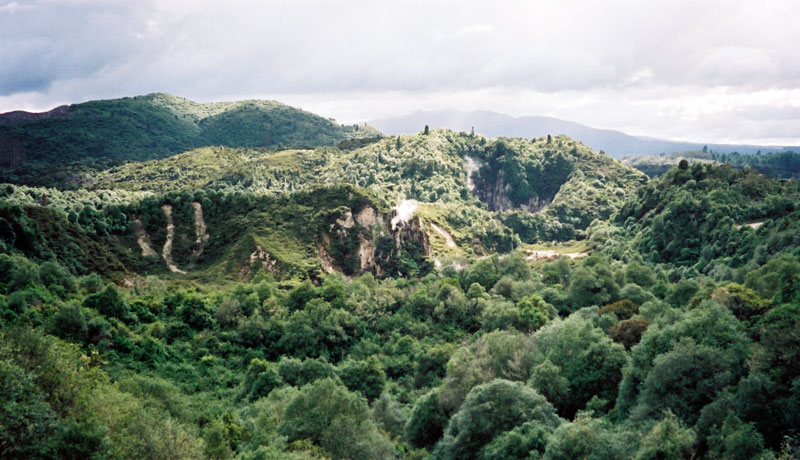Historic Waimangu Volcanic Valley
Country: New Zealand by Lisette
16-02-2005
Close to Rotorua on New Zealand’s northern island is Waimangu Valley. Mt. Tarawera erupted in 1886 and prior to the devastation people sighted the phantom war canoe (waka taua) that was believed to be a sign of death. This omen was discussed with tohunga Tuhoto Ariki, an expert priest, healer and/or advisor. He believed the entire region would be overwhelmed. When this indeed happened by the eruption, the tuhonga was mud-buried and resurrected alive after four days.
It is said that Lake Tarawera looked like a copper mirror, reflecting the mountain and the gloomy cloud-curtain from which “great balls of flaming rock dropped from time to time”.
I visited Waimangu Valley in awe – I had never seen what volcano eruptions could do and how the area would look like more than a century later. Original craters are filled with rainwater. Yet, each crater looks different from the other due to the different minerals in it. Continued geothermic activities make these lakes deadly; next to minerals, it hosts gas and temperatures vary from 55 to 90 degrees Celsius.
The eruption on June 10th, 1886 was even heard in the northeast of the South Island and Christchurch saw ash in the air while folks in Auckland thought Russian warships had come. Lakes became differently shaped, an entire Māori village was buried and the then famous Pink and White Terraces were destroyed. For years the land was uninhabited, but as the ground is very fertile the area was replanted with trees and plants and life came back.
I remember reading a lot about volcanic activities; the explanation was well done for those new to the science. My only discontent is that not much information was shared about Māori history in this area.
Here is a brief account of one of the legends about Mt. Tarawera. On the mountain lived a man-eating ogre, Tamahoi. Tohunga Ngatoroirangi became angered and went on expedition. He climbed the mountain and stamped his foot until a chasm was formed. He summoned Tamahoi, threw him into the chasm and covered him with rocks. The ogre had been asleep for centuries until he was summoned by tuhonga Tuhoto Ariki. Tuhoto was saddened by the European influence on his people and prayed to the gods for an answer to this. It is believed he was answered when Tamahoi threw molten rock and boiling mud and ash over the Māori villages.







Excellent article, but I would love to know about these legends.
This site gives you very good legends and contemporary stories. This particular story is also about a tohunga, but not the same one mentioned in the article.